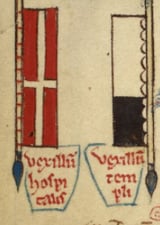The Templar Order had a gonfalon (a military standard of a specific type) of black and white called the beauseant (I have come to prefer the spelling most common in the book I first took it from though it's not a great historical source, namely, Walter Scott's 'Ivanhoe'). The Wikipedia link describes the Templar banner as:
Baucent (bauceant, baussant, etc.) was the name of the war flag (vexillum belli) used by the Knights Templar in the 12th and 13th centuries. 13th-century sources show it as a white gonfanon with a black chief (argent a chief sable).1 Jacques de Vitry, writing in the 1220s, mentions the gonfanon baucent and explains that the black and white colours symbolise the Templar's ferocity towards their enemies and their kindness towards their friends.
The name of the war-flag also came to be a battle-cry (though, traditionally, it's been my understanding that 'Deus Vult!' was the main battle-cry of the Templars though this information was gained from Jan Guillou's Crusader trilogy).
I came to wonder, as the Knights Hospitaller were quite similar after they turned into military orders (elder military monastic order, both extensive landholders in the Outremer, both popular with European gentility), -- how did the Knights Hospitallers' gonfalon look and did it also had a distinctive name? If they did, was this name also used as a battle-cry?
Edit: I just wanted to say that simple searches I have conducted have mostly brought up the fact that Templars were forbidden to flee the field of battle if a Hospitaller gonfalon was standing, which does indicate that the Hospitallers had one:
And if he sees there is nothing else for it, he should make for the nearest gonfalon of the Hospitallers, or some other Christians if there are any.
This still leaves the question of what this gonfalon looked like up in the air, however.

